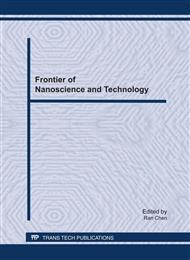[1]
N. V. Hieu, V. V. Quang, N. D. Hoa, D. Kim, Preparing large-scale WO3 nanowire-like structure for high sensitivity NH3 gas sensor through a simple route, Current Applied Physics Vol. 11 (2011), pp.657-661.
DOI: 10.1016/j.cap.2010.11.002
Google Scholar
[2]
G.N. Chaudhari, S.V. Jagtap, N.N. Gedama, M.J. Pawar, V.S. Sangawar, Sol–gel synthesized semiconducting LaCo0. 8Fe0. 2O3-based powder for thick film NH3 gas sensor, Talanta Vol. 78 (2009), pp.1136-1140.
DOI: 10.1016/j.talanta.2009.01.030
Google Scholar
[3]
P. K. Sekhar, E. L. Brosha, R. Mukundan, W. Li, M. A. Nelson, P. Palanisamy, F. H. Garzon, Application of commercial automotive sensor manufacturing methods for NOx/NH3 mixed potential sensors for on-board emissions control, Sensors and Actuators B Vol. 144 (2010).
DOI: 10.1016/j.snb.2009.10.045
Google Scholar
[4]
K. Choi, J. Park, K. Park, H. Kim, H. Park, S. Kim, Low power micro-gas sensors using mixed SnO2 nanoparticles and MWCNTs to detect NO2, NH3, and xylene gases for ubiquitous sensor network applications, Sensors and Actuators B Vol. 150 (2010).
DOI: 10.1016/j.snb.2010.07.041
Google Scholar
[5]
P. Su, C. Lee, C. Chou, Flexible NH3 sensors fabricated by in situ self-assembly of polypyrrole, Talanta Vol. 80 (2009), pp.763-769.
DOI: 10.1016/j.talanta.2009.07.057
Google Scholar
[6]
N. Peng, Q. Zhang, Y. Lee, O. Tan, N. Marzari, Gate modulation in carbon nanotube field effect transistors-based NH3 gas sensors, Sensors and Actuators B Vol. 132 (2008), pp.191-195.
DOI: 10.1016/j.snb.2008.01.025
Google Scholar
[7]
M. Breysse, B. Claudel, L. Faure, M. Guenin, R.J. Williams, T. Wolkenstein, Chemi- luminescence during the catalysis of carbon monoxide oxidation on a thoria surface, J. Catal. Vol. 45 (1976), pp.137-144.
DOI: 10.1016/0021-9517(76)90129-9
Google Scholar
[8]
T. Okabayashi, T. Fujimoto, I. Yamamoto, K. Utsunomiya, T. Wada, Y. Yamashita, N. Yamashita, M. Nakagawa, High sensitive hydrocarbon gas sensor utilizing cataluminescence of gamma-Al2O3 activated with Dy3+, Sens. Actuators B Vol. 64 (2000).
DOI: 10.1016/s0925-4005(99)00483-9
Google Scholar
[9]
T. Okabayashi, T. Toda, I. Yamamoto, K. Utsunomiya, N. Yamashita, M. Nakagawa, Temperature-programmed chemiluminescence measurements for discrimination and determination of fragrance, Sens. Actuators B Vol. 74 (2001), pp.152-156.
DOI: 10.1016/s0925-4005(00)00725-5
Google Scholar
[10]
P. McCord, S.L. Yau, A.J. Bard, Chemiluminescence of anodized and etched silicon: evidence, science Vol. 257 (1992), pp.68-71.
DOI: 10.1126/science.257.5066.68
Google Scholar
[11]
L. Koning, I. Rabin, W. Schulze, G. Ertl, Chemiluminescence in the agglomeration of metal clusters, science Vol. 274 (1996), pp.1353-1355.
DOI: 10.1126/science.274.5291.1353
Google Scholar
[12]
K.W. Zhou, P. Zhang, W. Chen, A Gaseous Ethanol Sensor Based on Cataluminescence on Nanometer Composite Oxide, Acta Chim. Sinica Vol. 68 (2010), pp.921-925.
Google Scholar
[13]
K.W. Zhou, H.W. Yang, P. Zhang, W. Chen, A sensitive benzene gas sensor utilizing thermal desorption coupled with cataluminescence, IEEE Int. Third ICMTMA (2011), pp.258-261.
Google Scholar
[14]
K.W. Zhou, X.R. Zhang, Determination of butanone in workshop air utilizing chemiluminescence on nanosized materials, Chinese Journal of Analytical Chemistry Vol. 32 (2004), pp.25-28.
Google Scholar
[15]
Z.Y. Zhang, H.J. Jiang, Z. Xing, X.R. Zhang, A highly selective chemiluminescent H2S sensor, Sens. Actuators B Vol. 102 (2004), pp.155-161.
DOI: 10.1016/j.snb.2004.04.015
Google Scholar
[16]
K.W. Zhou, X.L. Ji, N. Zhang, X.R. Zhang, On-line monitoring of formaldehyde in air by cataluminescence - based gas sensor, Sens. Actuators B Vol. 119 (2006), pp.392-397.
DOI: 10.1016/j.snb.2005.12.038
Google Scholar
[17]
L. Tang, Y. Li, K. Xu, X. Hou, Y. Lv, Sensitive and selective acetone sensor based on its cataluminescence from nano-La2O3 surface, Sens. Actuators B Vol. 132 (2008), pp.243-249.
DOI: 10.1016/j.snb.2008.01.031
Google Scholar


